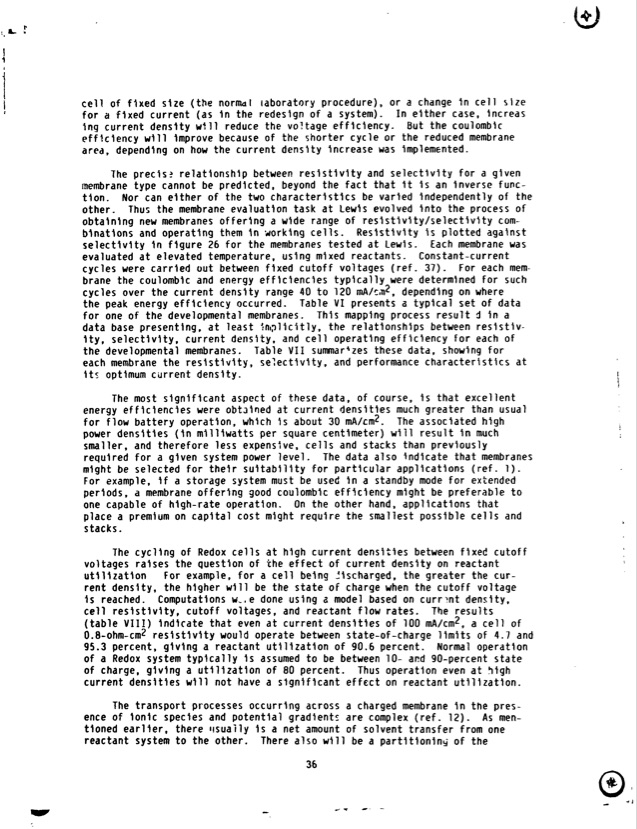
PDF Publication Title:
Text from PDF Page: 039
cell of fixed size (the normal laboratory procedure), or a change in cell size for a fixed current (as in the redeslgn of a system). In either case, increas ing current density wtll reduce the voltage efficiency. But the coulomblc effjciency w i l l improve because of the snorter cycle or the reduced membrane area, depending on how the current denslty increase was implemented. The precls? relationship between resistivity and selectivity for a glven membrane type cannot be predicted, beyond the fact that i t i s an inverse func- tion. Nor can either of the two characteristics be varied independently of the other. Thus the membrane evaluation task at Lewis evolved into the process of obtaining new membranes offering a wide range of resistivity/selectivity com- binations and operating them i n xorking cells. Resistivity i s plotted agalnst selectivity i n figure 26 for the membranes tested at Lewls. Each membrane was evaluated at elevated temperature, using mixed reactants. Constant-current cycles were carried out between fixed cutoff voltages (ref. 37). For each mem- brane the coulomblc and energy efflclencles typically were determined for such cycles over the current density range 40 t o 120 mA/c,n2, depending on where the peak energy efficiency occurred. Table V I presents a typical set of data for one of the developmental membranes. This mapping process result d in a data base presenting, at least :n~;llicitly, the relationships between reslstiv- Ity, selectivlty, current density, and cell operating efflciency for each of the developmental membranes. Table V I I summarizes these dab, showing for each membrane the resistivity, se:ectivity, and performance characteristics at I t s optimum current density. The most significant aspect of these data, of course, i s that excellent energy efficiencies were obt~inedat current denslties much greater than usual for flow battery operation, which i s about 30 mA/cm2. The associated high power densities ( i n milliwatts per square centimeter) w i l l result i n much smaller, and therefore less expensjve, cells and stacks than previously required for a given system power level. The data also Indicate that membranes might be selected for their suitability for particular applications (ref. 1). For example, i f a storage system must be used i n a standby mode for extended periods, a membrane offering good coulomblc efflciency might be preferable t o one capable of high-rate operatlon. On the other hand, applications that place a premium on capital cost might require the smallest possible cells and stacks. The cycling of Redox cells at hlgh current denslties between fixed cutoff voltages raises the question of the effect of current density on reactant utilization For example, for a cell being jischarged, the greater the cur- rent density, the higher will be the state of charge when the cutoff voltage i s reached. Computations w.,e done using a model based on curr?nt density, cell resistlvity, cutoff voltages, and reactant flow rates. The results (table VIII) indicate that even at current densities of 100 m~/cm~a, cell of 0.8-ohm-cm2 resistivity would operate between state-of-charge l i mi t s of 4.7 and 95.3 percent, giving a reactant utilization of 90.6 percent. Normal operatlon of a Redox system typically i s assumed to be between 10- aod 90-percent state of charge, giving a utilizatlon of 80 percent. Thus operatlon even at 3igh current densities will not have a significant effect on reactant utilization. The transport processes occurring across a charged membrane I n the pres- ence of ionic species and potential gradlents are complex (ref. 12). As men- tioned earlier, there llsuaily is a net amount of solvent transfer from one reactant system t o the other. There also w i l l be a partition in^ of thePDF Image | NASA Redox Storage System Development Project

PDF Search Title:
NASA Redox Storage System Development ProjectOriginal File Name Searched:
19850004157.pdfDIY PDF Search: Google It | Yahoo | Bing
CO2 Organic Rankine Cycle Experimenter Platform The supercritical CO2 phase change system is both a heat pump and organic rankine cycle which can be used for those purposes and as a supercritical extractor for advanced subcritical and supercritical extraction technology. Uses include producing nanoparticles, precious metal CO2 extraction, lithium battery recycling, and other applications... More Info
Heat Pumps CO2 ORC Heat Pump System Platform More Info
| CONTACT TEL: 608-238-6001 Email: greg@infinityturbine.com | RSS | AMP |